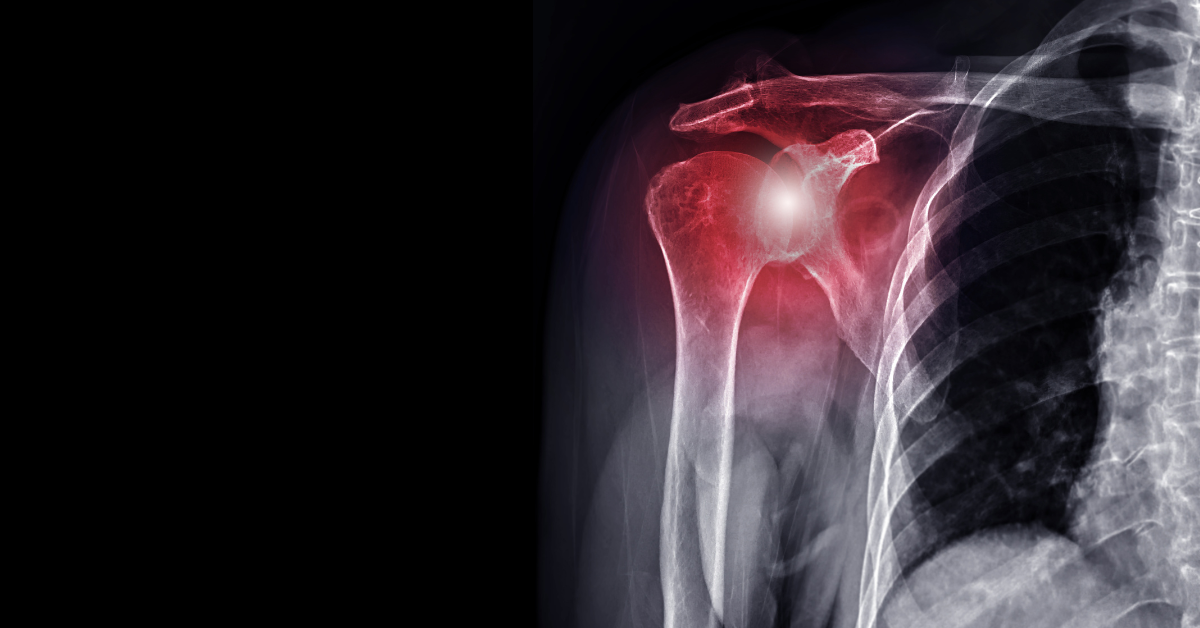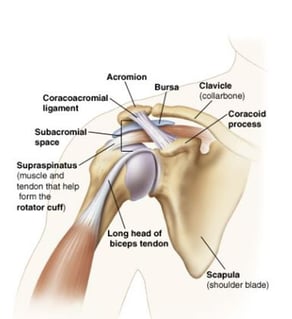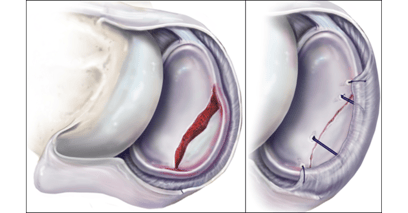Shoulder Instability in Athletes

Understanding Shoulder Instability for Athletes
In this comprehensive guide to shoulder instability we will cover common causes, symptoms and treatment options for athletes experiencing shoulder instability.
Shoulder instability is relatively common in athletes, accounting for between 4-8% of all athletic injuries. Unfortunately, shoulder instability is rarely just a one time injury, since once you have dislocated your shoulder initially, you are 87% more likely to have a second shoulder dislocation if you continue in your sports.
What is Shoulder Instability?
The shoulder is a ball and socket joint that requires a high amount of mobility to perform athletic movements like throwing, catching, hitting, and even running. The mobility requirements of the shoulder joint make it relatively unstable, with very little passive support and stability.
While the shoulder is called a “ball and socket” joint, it is really shaped more like a golf ball on a tee. There is a very shallow bony support of the glenoid that is buttressed slightly by a labrum that deepens the socket. There are several ligaments and joint capsules that support the shoulder, but these soft tissue structures are relatively loose to allow full range of motion of the shoulder.
With minimal passive support of the shoulder, it puts extra emphasis on dynamic stability using muscular support. Primarily, the rotator cuff muscles aid in stabilizing the shoulder and keeping the ball centered on the socket.
Essentially, shoulder instability occurs anytime the golf ball falls off the tee. This results in either a shoulder dislocation, where the ball slides off the socket and remains out of place, or with a subluxation, where the ball slides out of the socket but immediately relocates on its own.
Shoulder dislocation and subluxation can occur in several different ways. The most common form of shoulder instability is when the shoulder dislocates anteriorly, or slides out of the front of the joint. However, it can also slide out of the back of the joint resulting in posterior instability.
There is a third type of instability called multi-directional instability. This is much less common overall, and is a result of congenital anomalies. Essentially, the tissues around the shoulder are not strong enough to support the shoulder and the shoulder dislocates frequently in a variety of different directions.
Common Causes of Shoulder Instability in Athletes
Most commonly, shoulder instability results from a traumatic injury, like a fall on an outstretched arm, a tackle or other forms of direct contact. The shoulder is most vulnerable to dislocation in positions away from the body, like reaching overhead or out to the side.
Repetitive overuse in overhead motions like throwing a ball or striking a volleyball can gradually weaken the passive tissues around the shoulder and lead to a higher risk of developing shoulder instability overtime. It is less common to have a single traumatic episode of shoulder instability from non-contact mechanisms.
People suffering from multi-directional instability that have congenital lax tissues can dislocate in many different positions. There may not be a single episode or event that causes the instability, but it can occur from “normal” day to day movements.
Recognizing the Common Symptoms of Shoulder Instability
Symptoms During the Injury
Commonly with an initial dislocation, an athlete will feel a sensation that their shoulder “slipped out.” This will be accompanied with pain, loss of strength and loss of motion. Often they will walk off the field or court with their arm dangling at their side.
Shoulder instability can either occur as a dislocation where the shoulder stays out of the joint until it is manually relocated by a trained medical professional, or it might relocate on its own.
Symptoms After the Injury
After the initial injury, the pain will gradually resolve, but loss of range of motion and weakness will continue. Additionally, it is fairly common to feel a general “looseness” of the shoulder and have a sensation that the shoulder may slip out again with basic movements.
Unfortunately, after an initial dislocation or instability episode, you are much more likely to dislocate again in the future. As many as 87% of athletes between the ages of 15-20 years old experienced recurrent instability episodes, or that their shoulder “slipped out” a second time.
If you experience symptoms of shoulder dislocation and feel your shoulder “slip out”, it is important to follow up with a medical professional. Dislocation can result in injuries to the bone, arteries or nerves of the arm. It is important to have the shoulder checked out and to make sure that it was relocated correctly to ensure the best possible outcomes long term.
Diagnostic Tests for Shoulder Instability
Clinically, the best test for shoulder instability is the apprehension-relocation test. This test puts the shoulder out to the side, in the most vulnerable position for shoulder dislocation. Commonly, the patient will report "apprehension", or a sensation that the shoulder is going to slip out. We then provide a little extra stability by pressing down on the front of the shoulder, which relieves the apprehension that the shoulder might slip out.
Typically, a clinical exam is also followed up with at least an x-ray. The x-ray is important to ensure that the joint is properly relocated (the ball is sitting back in the socket), and it can also show any bony injuries to the joint, like a bony bankart injury or a hill-sachs lesion.
Many athletes will also undergo an MRI that will confirm how much injury occurred to the soft tissue during the dislocation. Most commonly, there will be injuries to the labrum (called a bankart tear), damage to the shoulder capsule, and sometimes rotator cuff damage or cartilage injuries. The MRI will give a full picture to the extent of the injury and allow for a clear plan moving forward.
Preventing Shoulder Instability in Athletes
With a recurrence rate of 87% following an initial shoulder dislocation. One of the best things you can do as an athlete is prevent shoulder instability from occurring in the first place.
The following exercises are proven strategies and exercises that help strengthen the shoulder joint and reduce risk of shoulder instability in athletes.
Shoulder Strengthening Exercises for Athletes
Rotator Cuff
The rotator cuff’s job is to help stabilize the shoulder joint and keep the ball on the socket. It is key for dynamic control and stability of the shoulder.
These two exercises are great ways to work on rotator cuff strength:
Straight Arm Band External Rotation
TRX External Rotation
Shoulder Blade
The shoulder blade muscles also have to work to create a stable platform for the shoulder to move and to properly position the shoulder for athletic activities.
TRX Y’s
Bear Position Push Backs
Proprioception
Lastly, to create shoulder stability the muscles need to fire at the right time and have good proprioception. That is a fancy way of saying that your brain needs to know where your arm is in space so it can help keep the shoulder in an optimal position.
Bottoms Up Overhead Carry
Tips for Injury Prevention and Proper Technique
There are two other simple things that an athlete can do to reduce the risk of developing shoulder instability.
- Maintain upper body strength training. There is a wide body of scientific research that shows following an organized strength and conditioning program during a sports season will help decrease the risk of acute injuries like shoulder instability. This will help maintain the strength, range of motion and coordination of the body throughout a long season. Even 1-2x/week is enough to see the benefit of reduced injury risk.
- Perform a warm up before every game and practice. Performing a simple 8-12 minute warm up before practice and games will not only enhance your performance but will also reduce your risk of injury. For contact sports, we recommend incorporating weight bearing shoulder exercises (like push ups or crawl variations) to help prepare the body for the demands of the sport.
Treating Shoulder Instability in Athletes
Each episode of shoulder instability is different and managed in a unique way based on the severity of the injury, the goals of the athlete, and the time frame for recovery.
For example, for athletes that want to return to a contact sport, a surgical path is often recommended due to the high rate of recurrent shoulder instability. However, for people dealing with congenital multi-directional instability, conservative rehabilitation and physical therapy is almost always recommended.
Non-Surgical Treatment Approaches
Some athletes (especially athletes that don’t play contact sports) are able to fully recover from shoulder instability without surgery. This process will involve a qualified sports physical therapist that specializes in working with athletes to return to performance and reduce the risk of future shoulder instability as an athlete returns to sport.
The conservative rehabilitation process involves restoring strength, some range of motion, and ultimately the function of the arm for the athlete's sport. The time frame will vary depending on the severity of the injury and the demands of the sport the athlete wants to return to.
Often, during the conservative rehab process, we do not attempt to recover the full range of motion of the shoulder. Following shoulder instability, our biggest concern is future instability, so we will often recommend purposely allowing the shoulder to get “tight” to help increase the stability of the shoulder. We work with each individual athlete to determine how much range of motion they need to function and perform their sport or activity and work to restore the necessary motion without any extra motion.
Some athletes may elect to go through conservative rehab temporarily to return to finish a sport season and then later choose to go through a surgical procedure to help stabilize the shoulder during an off-season. The overall process is the same with these athletes, but the time frames and goals may be pushed up slightly.
Often following conservative management for shoulder instability, we will recommend that athletes wear a shoulder harness that helps provide some extra support to the shoulder. It can also help limit the shoulder's range of motion and keep the arm out of the most vulnerable positions. While it is not a permanent solution, it can be a temporary assist to help keep athletes safe as they return to the field. You can think of it as a “seat belt” for the shoulder.
Sometimes, modifications might be needed for the athlete's exercise and training routine as they go through conservative management. Oftentimes, pressing motions like overhead presses or bench pressing, and hanging movements like pull ups might be difficult on the shoulder and cause pain or instability. These movements might need to be avoided or modified initially as the athlete goes through conservative management for shoulder instability.
Surgical Interventions for Shoulder Instability
There are a variety of good surgical techniques to help stabilize the shoulder following shoulder instability. The exact surgical procedure performed will be dependent on the extent of the initial injury and the specific tissues that were damaged. We recently recorded a podcast with Dr. Chris Kilian, an orthopedic surgeon from Orthopedic Associates of Wisconsin, who went into detail on the different surgical approaches to shoulder instability.
The most common surgical procedure for shoulder instability is an arthroscopic bankart repair that fixes the labrum and improves the passive stability of the shoulder.
For a more significant shoulder dislocation with more bony damage to the socket, some surgeons will elect to perform a Latarjet procedure. This is a more significant surgery that takes bone from the shoulder blade and moves it over to help deepen the shoulder socket.
For athletes that have a hill sachs lesion on their humerus following a dislocation, the surgeon may elect to perform a remplissage procedure that helps to reshape the humeral head and make the shoulder more stable. This procedure may be combined with either a bankart repair or latarjet procedure based on the injuries.
All of these surgeries will require a thorough rehabilitation process with a sports physical therapist and have a 5-8+ month recovery process before returning to contact sports.
Rehabilitation and Return to Sport for Athletes with Shoulder Instability
For both conservative management and postoperative rehabilitation after shoulder instability, working with a qualified sports physical therapist is key. The overall process and steps of both conservative rehabilitation and postoperative rehabilitation are the same, but the postoperative protocol will be slower to allow the surgical repairs time to fully heal.
At Kinetic Sports Medicine and Performance, we don’t believe in time-based rehabilitation protocols, but prefer criteria-based progressions. We recommend using objective measurements - like range of motion, objective strength testing and performance-based tests to determine the athlete's readiness to progress from one stage to the next.
Each athlete's recovery is different, and no one follows the exact same path back to full performance. The only way to individualize a rehabilitation program is to use objective data to ensure each athlete is progressing safely and being challenged appropriately at each stage.
Post-Operative Rehabilitation Protocol
Every post-operative rehabilitation protocol will be different based on the specific procedure that was done and the individual surgeon's preference. Always refer to your surgeon’s protocol for specific guidance.
Stage 1: Protection phase
- Typically in a sling for 4-6 weeks
- Limited range of motion activities, depending on the exact surgical procedure done
- Able to perform forearm, grip exercises with arm supported
- Able to start low level isometric exercises for shoulder strength with pain free intensity
Example exercises:
Stage 2: Intermediate Phase
- Typically out of sling
- Gradually working toward full range of motion
- Working to restore strength of the shoulder muscles and shoulder blade muscles
- Starting low level weight bearing progressions
Example Exercises:
Stage 3: Advanced Activity Phase
- Working back into normal upper body strength training
- Starting plyometric activity
- Working on strength and control in more vulnerable shoulder positions
Example Exercises:
Stage 4: Return To Activity Phase
- Start progressing to overhead strengthening motions
- Progress plyometric activities
- Go through impact progression
- Begin return to sport progression
Example exercises:
Tips for Safe Return to Sports
The return to sport phase of a rehabilitation program is one of the most important aspects of any protocol. It needs to be gradual, progressive and monitored closely for how the athlete responds to reduce the risk of re-injury.
We break this process down into 3 stages: return to participation, return to play and return to performance.
During the return to participation phase, the athlete will gradually begin reintegrating into team activities like workouts and practice.
For contact sport athletes, this often begins with non-contact drill work that gradually progresses into contact drill work, limited field scrimmaging and then finally live scrimmaging in practice.
For throwing or hitting sports, this is the stage that will begin with a throwing program or other interval return to sport program where we gradually increase both the number of throws or swings, and the intensity of the throws and swings.
Once an athlete has successfully completed a full return to practice, it is time to get back in the game! This may include modifications like reduced playing time, or wearing a protective shoulder harness as they reintegrate back into their sport.
Finally, the return to performance phase is when the athlete is not only back on the field with their teammates competing, but back to 100% performance. There are no more restrictions on minutes played, pitches thrown or swings taken, and the athlete is performing at the same level they were before the injury. Unfortunately, not everyone reaches this phase. It is important to take the rehabilitation process seriously, follow the program and work hard to get all the way back!
At Kinetic Sports Medicine and Performance we specialize in sports physical therapy and helping athletes recover from shoulder instability. In the last year we have helped hockey players, football players, baseball players, lacrosse players, basketball players, soccer players and golfers return from a shoulder dislocation both following surgery and through conservative management. If you have any questions about your specific injury or situation, schedule a free 15 minute phone consultation with one of our physical therapists today.




.png?width=336&height=176&name=blog%20images%20(1).png)
.png?width=458&height=240&name=blog%20images%20(2).png)